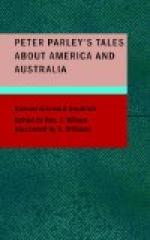They are hideously ugly, with flat noses, wide nostrils, eyes sunk in the head, and overshadowed with thick eyebrows. The mouth very wide, lips thick and prominent, hair black, but not woolly; the colour of the skin varies from dark bronze to jet black. Their stature is below the middle size, and they are remarkably thin and ill-made.
To add to their natural deformity, they thrust a bone through the cartilage of the nose, and stick with gum to their hair matted moss, the teeth of men, sharks, and kangaroos, the tails of dogs, and jaw-bones of fish.
On particular occasions they ornament themselves with red and white clay, using the former when preparing to fight, and the latter for the more peaceful amusement of dancing. The fashion of these ornaments was left to each person’s taste, and some, when decorated in their best manner, looked perfectly horrible: nothing could appear more terrible than a black and dismal face, with a large white circle drawn round each eye.
[Illustration]
They scarify the skin in every part with sharp shells.
The women and female children are generally found to want the first two joints of the little finger of the left hand, which are taken off while they are infants, and the reason they assign is, that they would be in the way in winding the fish-lines over the hand.
The men all want one of their front teeth, which is knocked out when they arrive at the age of fifteen or sixteen, with many ridiculous ceremonies; but the boys are not allowed to consider themselves as men before they have undergone that operation.
They live chiefly on fish, which they sometimes spear and sometimes net; the women, on the parts of the coast, aiding to catch them with the hook and line.
“The facility,” (observes Captain Sturt), “with which they procured fish was really surprising.
“They would slip, feet foremost, into the water, as they walked along the bank of the river, as if they had accidentally done so; but, in reality, to avoid the splash they would have made if they had plunged in head foremost.
“As surely as a native disappeared under the surface of the water, so surely would he re-appear, with a fish writhing upon the point of his short spear.
“The very otter scarcely exceeds them in power over the finny race, and so true is the aim of these savages, even under the water, that all the fish we procured from them were pierced either close behind the lateral fin or in the very centre of the head.”
[Illustration]
If a dead whale happens to be cast on the shore, numbers flock to it, from every part of the coast, and they feast sumptuously while any part remains.
Those in the interior are stated to live on grubs, insects, ants and their eggs, kangaroos, when they can catch them, fern roots, various kinds of berries, and honey; caterpillars and worms also form part of their food.




